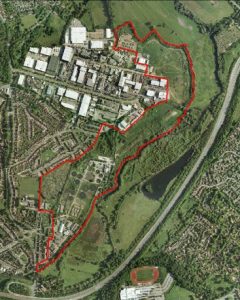 Abraham Lincoln
If given the truth, the people can be depended upon to meet any national crisis...
Abraham Lincoln
If given the truth, the people can be depended upon to meet any national crisis...
 Guildford news...
for Guildford people, brought to you by Guildford reporters - Guildford's own news service
Guildford news...
for Guildford people, brought to you by Guildford reporters - Guildford's own news service
Letter: Move Industrial Units to Slyfield and Use Walnut Tree Close for Residential
Published on: 6 Jun, 2019
Updated on: 5 Jun, 2019
 From Helen Jefferies
From Helen Jefferies
In response to: Slyfield Area Regeneration Project (SARP) Launched And Rebranded ‘Weyside Urban Village’
Am I the only person who thinks that a more sensible alternative would be to move the light industrial units from Woodbridge Meadows/Walnut Tree Close to the Slyfield estate and put the housing announced for SARP closer to the station and jobs in the town centre on WTC/Woodbridge Meadows?
The argument for not building on Walnut Tree has hitherto been partly due to flooding concerns, yet only a few thousand metres downstream the flood risk appears to have disappeared.
One of the advantages would be that the huge trucks delivering to the light industrial units could be more easily accommodated in Slyfield and presumably the Thames Water treatment plant could remain in situ, the cost savings invested in sustainable transport initiatives, and so on.
Responses to Letter: Move Industrial Units to Slyfield and Use Walnut Tree Close for Residential
Leave a Comment Cancel reply
Please see our comments policy. All comments are moderated and may take time to appear. Full names, or at least initial and surname, must be given.
Click on cartoon for Dragon story: Public Asked for Views on SCC’s Proposal for Reduced Speed Limits


Recent Articles
- Letter: Will GBC’s New Planning Document on Building Heights Be Effective?
- Proposed New Leisure Contract Should Improve Facilities and the Council’s Income
- Witness Appeal Following Fatal Collision
- Celebration at Guildford Cathedral of its Latest and Future Church Leaders
- Photo Feature: Now You See It…
- Letter: Snail-paced Progress for Full Weir Repair
- Mayor’s Diary: July 5 -July 20
- One Homeowner Recompensed but Fight Continues Over Waverley CIL Charges
- Letter: Fine Those Guilty of Anti Social Behaviour
- GBC Working Hard To Mitigate Looming Weyside Urban Village Deficit


Recent Comments
- Jan Messinger on Public Asked for Views on SCC’s Proposal for Reduced Speed Limits
- Fiona White on GBC Asks Residents for Views on Its Draft Building Height Guidance
- Dave Middleton on Letter: Fine Those Guilty of Anti Social Behaviour
- Carina Coverly on GBC Asks Residents for Views on Its Draft Building Height Guidance
- M Durant on Online Event Will ‘Help Residents Have Their Say On Local Government Reorganisation’
- Jim Allen on GBC Working Hard To Mitigate Looming Weyside Urban Village Deficit
Search in Site
Media Gallery
Dragon Interview: Local Artist Leaves Her Mark At One of England’s Most Historic Buildings
January 21, 2023 / No Comment / Read MoreDragon Interview: Lib Dem Planning Chair: ‘Current Policy Doesn’t Work for Local People’
January 19, 2023 / No Comment / Read MoreA3 Tunnel in Guildford ‘Necessary’ for New Homes, Says Guildford’s MP
January 10, 2023 / No Comment / Read More‘Madness’ for London Road Scheme to Go Ahead Against ‘Huge Opposition’, Says SCC Leader
January 6, 2023 / No Comment / Read MoreCouncillor’s Son Starts Campaign for More Consultation on North Street Plan
December 30, 2022 / No Comment / Read MoreCounty Council Climbs Down Over London Road Works – Further ‘Engagement’ Period Announced
December 14, 2022 / No Comment / Read MoreDragon Interview: GBC Reaction to the Government’s Expected Decision to Relax Housing Targets
December 7, 2022 / No Comment / Read MoreHow Can Our Town Centre Businesses Recover? Watch the Shop Front Debate
May 18, 2020 / No Comment / Read More






Jim Allen
June 6, 2019 at 9:22 am
The flood risk has not disappeared merely the navigation which should be run at under 2 knots is being run at 8 knots with the subsequent predicted loss of 120 trees with bank erosion 30 trees have already been lost. Scouring at Bowers weir has ripped the bed out of the navigation so instead of 4 feet deep it now has a depth of 12 feet.
David Smith
June 6, 2019 at 8:07 pm
People need to realise that developing town centres in real life is not like Sim City. It’s unlikely that the council owns any land in Walnut Tree Close and most of what is undeveloped has planning consents attached to it. The reason the sites on the river side of the road are not being developed is because of the lack of flood protection and it’s up to the developers to come up with a solution as the Environment Agency are sitting on their hands.
Slyfield makes sense – for one reason the sewage works are probably outdated and Thames Water could benefit from a brand new facility. Secondly, this is a cheaper part of town and could be used to deliver much needed affordable housing and cheaper private housing compared to prime parts of town.
It really is sad to see the same critics (not the writer of this letter) criticising yet another proposed development in the town. I mean is there anywhere we can build without someone complaining?
Helen Jefferies
June 7, 2019 at 9:10 am
My point is that the council had always argued that flood risk prevented Walnut Tree Close being used for housing. The SARP Plan shows houses along the river. I don’t understand why it’s ok to build houses on the river at SARP but not at WTC. Surely the flood risk is similar? I understand it might not be exactly the same but £60-£90 million saved from not moving Thames Water’s sewage treatment centre should buy quite a bit of flood mitigation, if it’s needed.
Fiona Curtis
June 7, 2019 at 3:08 pm
I have family who lives in new housing on the esplanade at Rochester. The area is subject to sea flooding but the houses are unaffected because they have basement and garage facilities below and are raised to allow for flooding. Many seafront and riverfront properties are built this way.
Perhaps its a case of where there’s a will there’s a way?
George Potter
June 7, 2019 at 5:18 pm
I don’t know for certain but I imagine one of the key differences between the SARP and Walnut Tree Close is that the former is adjacent to a natural floodplain and wildlife preserve which can absorb flooding more easily.
Also, anyone who has taken a trip along Walnut Tree Close lately will have noticed that the light industrial units along that road are gradually being closed down one by one and being redeveloped into accommodation anyway.
George Potter is a Lib Dem councillor for Burpham.
Bibhas Neogi
June 11, 2019 at 8:26 am
I presented a document to Guildford Vision Group in May 2012 when suggestions for improvements were invited by GUildford Vision Group. It is now in GVG’s archives.
In that document I included my ideas about how to reduce traffic congestion in Guildford, a new crossing over the railway, relocation of the bus station and alteration of the routes, a new Walnut Bridge, a high level walkway from the railway station to the Friary and possible widening of the A3 etc.
Many other suggestions have since been added and some supersede the older ideas. However, GVG and the Guildford Society have come up with similar ideas much later.
In the context of Helen Jefferies’ comment about whether she was the only one who suggested removing light industrial units from Walnut Tree Close to make room for residential housing, I can assure her that I mentioned this possibility (in the last paragraph of that document) as well but at that time there was no SARP or ‘Urban Village’ proposal.
In the end it is not so important as to who aired these ideas first but whether the councils take any notice of them and act on the suggestions they find relevant and explore them further.
Bibhas Neogi
June 12, 2019 at 8:44 am
For those who are interested in the document I presented to Guildford Vision Group in May 2012,it can be found in
http://www.guildfordvisiongroup.com/wp-content/uploads/2012/04/Gyratory_website_rev11.pdf
As I said, many other suggestions have since been added and some supersede the older ideas. Please see my website http://www.spanglefish.com/revampguildfordgyratory/
The important additions are:
1) a tunnel taking the A281 from Shalford, with a spur connecting the A3100 at Artington, to the A25 Parkway to reduce traffic through the town centre;
2) lowering the stretch of the A281 from Quarry Street junction to York Road roundabout into a tunnel-like structure to make the town centre pedestrian friendly and;
3) an A3 widening idea that retains the two bridges – one carrying the slip road to Farnham and the other that carries the A31 over the A3. I believe that this would cause the least disruption to both the A3 and the A31 traffic, would be the most cost-effective and environmentally preferable widening scheme for this location.